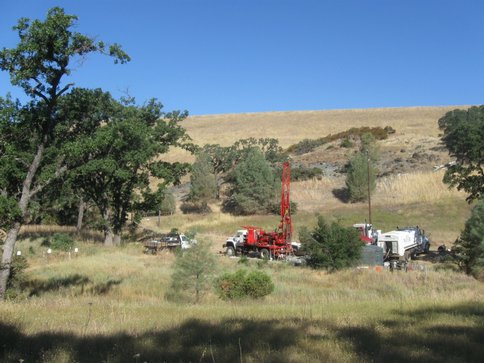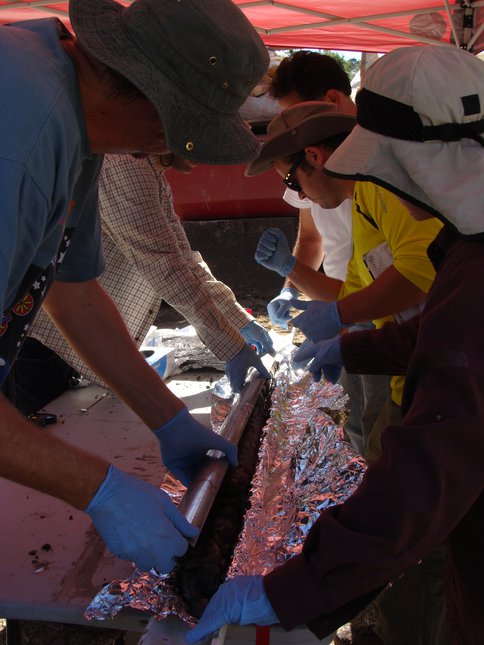2011 Annual Science Report
 NASA Ames Research Center
Reporting | SEP 2010 – AUG 2011
NASA Ames Research Center
Reporting | SEP 2010 – AUG 2011
Mineralogical Traces of Early Habitable Environments
Project Summary
The goal of our work is to discern the habitability (potential to support life) of ancient Martian environments, with an emphasis on understanding which environments could have supported more life than others. This information will help to guide the selection of sites on the Martian surface, for future missions designed to seek direct evidence of life. Our approach has two main parts: 1. We will use the presence of specific minerals or groups of minerals – an analysis that can be performed robotically on Mars — to constrain the chemical and physical conditions of the ancient environments in which they formed. 2. We will characterize the distribution of life on Earth in a series of environments spanning those same parameters, in order to inform the first portion of the investigation.
Project Progress
Our activities were strongly focused on field operations at the McLaughlin Natural Reserve. McLaughlin offers an important venue for understanding the biological potential of serpentinizing systems, in two regards. First, the site differs from many previously studied examples of serpentinizing systems in several respects, and therefore contributes diversity to the set of environments in which we can understand the relationship between biology and serpentinized rocks/fluids. Second, the site offers a unique opportunity to access subsurface communities through drilling and time-resolved down-hole experimentation.
FIGURE 1. Drilling operations at the McLaughlin Natural Reserve
We conducted a series of site-assessment field trips to McLaughlin to characterize the chemistry, microbial community structure, and metabolic activity of waters collected from a suite of existing wells sunk into serpentinizing ground. Early results show waters of clearly serpentinized character (high pH and low dissolved inorganic carbon), but with considerably lower dissolved H2 content than most studied sites. Microbial community structure is superficially comparable to that observed in spring effluents from several other, geographically diverse serpentinizing systems. Active biological consumption of both H2 and CO was documented, in waters having pH up to 11.5.
FIGURE 2. Team members prepare to sample a freshly recovered core from the McLaughlin Drilling Project.
Subsequently, and with support from a NAI DDF award to Dawn Cardace, we undertook a two-week drilling project to collect cores and establish wells at a variety of depths and targeted sites, within the McLaughlin reserve. One core was retrieved from each of two sites, to depths of 125-150 feet, and a series of satellite wells (no core retrieval) were sunk adjacent to the primary holes, at depths determined to be of interest based on preliminary core analysis. These wells tap a variety of horizons indicative of serpentinizing conditions, including pH up to 11.7 and super-saturated methane. Along with core archival, depth-resolved samples were collected for analysis of microbial community structure (DNA and cDNA libraries, and metagenomic content), organic geochemistry, and mineralogy. The established wells will be monitored in time course for aqueous chemistry, and will be used for down-hole deployment of microbial growth experiments. Initial experiments (using methodology identical to that described for the established wells) did not show biological consumption of H2 or CO, possibly commensurate with the limited energy available in these metabolisms in the horizons accessed by drilling.
FIGURE 3. Student interns Addien Wray and Diana Bolser (standing, left and right, respectively) and NASA Postdoctoral Program associate Sanjoy Som (center) sample and process well water at the McLaughlin Reserve.
We also utilized samples collected from our Josephine Ophiolite locale to conduct comparative analyzes using instruments comparable to the ChemCam and CheMin MSL instruments, as a means of informing Mars surface operations by ground-truthing against well-studied terrestrial locales. Finally, we field deployed a prototype of a hybrid Moessbauer-XRD instrument at our Hawaiian field site. The prototype is intended for development as a sample screening instrument (screening-level assessment of habitability from mineralogy) for use on future Mars missions.
Publications
-
Allen, M. A., Neilan, B. A., Burns, B. P., Jahnke, L. L., & Summons, R. E. (2010). Lipid biomarkers in Hamelin Pool microbial mats and stromatolites. Organic Geochemistry, 41(11), 1207–1218. doi:10.1016/j.orggeochem.2010.07.007
-
Alperin, M., & Hoehler, T. (2010). The Ongoing Mystery of Sea-Floor Methane. Science, 329(5989), 288–289. doi:10.1126/science.1189966
-
Anderson, R. B., Morris, R. V., Clegg, S. M., Bell, J. F., Wiens, R. C., Humphries, S. D., … McInroy, R. (2011). The influence of multivariate analysis methods and target grain size on the accuracy of remote quantitative chemical analysis of rocks using laser induced breakdown spectroscopy. Icarus, 215(2), 608–627. doi:10.1016/j.icarus.2011.07.034
-
Crumpler, L. S., Arvidson, R. E., Squyres, S. W., McCoy, T., Yingst, A., Ruff, S., … Hurowitz, J. (2011). Field reconnaissance geologic mapping of the Columbia Hills, Mars, based on Mars Exploration Rover Spirit and MRO HiRISE observations. Journal of Geophysical Research, 116. doi:10.1029/2010je003749
-
Hoehler, T. M., & Westall, F. (2010). Mars Exploration Program Analysis Group Goal One: Determine If Life Ever Arose on Mars. Astrobiology, 10(9), 859–867. doi:10.1089/ast.2010.0527
-
Orphan, V. J., & Hoehler, T. M. (2011). Microbiology: Hydrogen for dinner. Nature, 476(7359), 154–155. doi:10.1038/476154a
-
Schroder, C., Klingelhofer, G., Morris, R. V., Bernhardt, B., Blumers, M., Fleischer, I., … De Souza, P. A. (2011). Field-portable Mossbauer spectroscopy on Earth, the Moon, Mars, and beyond. Geochemistry: Exploration, Environment, Analysis, 11(2), 129–143. doi:10.1144/1467-7873/09-iags-018
-
Treiman, A. H., & Essene, E. J. (2011). Chemical composition of magnetite in Martian meteorite ALH 84001: Revised appraisal from thermochemistry of phases in Fe–Mg–C–O. Geochimica et Cosmochimica Acta, 75(18), 5324–5335. doi:10.1016/j.gca.2011.06.038
-
Vogel, M. B., Des Marais, D. J., Parenteau, M. N., Jahnke, L. L., Turk, K. A., & Kubo, M. D. Y. (2010). Biological influences on modern sulfates: Textures and composition of gypsum deposits from Guerrero Negro, Baja California Sur, Mexico. Sedimentary Geology, 223(3-4), 265–280. doi:10.1016/j.sedgeo.2009.11.013
- , H.E.F. & Team, A. (2011). A terrestrial analogue from Spitsbergen (Svalbard, Norway) for the Comanche carbonate at Gusev Crater. Mars. Lunar Planetary Science 42.
- Achilles, C.N., Ming, D.W., Morris, R.V. & Blake, D.F. (2011). Detection limit of smectite by the CheMin IV laboratory instrument: Preliminary implications for CheMin on the Mars Science Laboratory Mission. LPSC, 42.
- Amundsen, H.E.F., Benning, L., Blake, D.F., Fogel, M., Ming, D., Skidmore, M., Steele, A. & Team, M. (2011). Cryogenic origin for Mars analog carbonates in the Bockfjord volcanic Complex. LPSC 42. Svalbard Norway.
- Anderson, R.B., Morris, R.V., Clegg, S.M., Bell III, J.F., Humphries, S.D. & Wiens, R.C. (2011). A comparison of multivariate and pre-processing methods for quantitative laser-induced breakdown spectroscopy of geologic samples. Lunar Planet. Sci., XLII.
- Blake, D.F., Treiman, A.H., Morris, R.H., Bish, D.A., H.E.F, A., Steele, A. & Team, A. (2011). Carbonate cements from the Sverrefjell and Sigurdfjell volcanoes. Lunar Planetary Science 42. Svalbard Norway.
- Cardace, D. & Hoehler, T.M. Extremophiles in serpentinizing systems. In: Rajakaruna, H.a. (Eds.). Serpentine: A Model for Evolution and Ecology. University of California Press.
- Cardace, D., Meyer-Dombard, D.R., Hoehler, T.M. & Uzunlar, N. (2010). Complex serpentinizing systems and the deep biosphere: metabolic opportunities depend on the geochemistry of mixing waters. AGU. San Francisco, CA.
- Des Marais, D.J. (2010). Exploring Mars for evidence of habitable environments and life. Proc. Amer. Phil. Soc, 154: 402-421.
- Des Marais, D.J. (2010). Formation and preservation of evidence for habitable environments on Mars. 242nd American Chemical Society Annual Meeting. Denver, CO.
- Des Marais, D.J. (20101). The new Mars: Astrobiology of a neighbor planet. GSA Annual Meeting & Exposition. Denver, CO.
- Ehlmann, B.L., Cardace, D., Hoehler, T., Blake, D. & Kelemen, P. (2011). Terrestrial serpentinizing systems as mineralogical, geochemical (and biological?) analogs for Mars. Analogue sites for Mars missions: MSL and beyond. The Woodlands, TX.
- Golden, D.C., Koster, A.M., Ming, D.W., Morris, M.S.A. & Graff, T.G. (2011). Experimental acid weathering of Fe-bearing Mars analog minerals and rocks: Implications for aqueous origin of hematite-bearing sediments in Meridiani Planum. Mars, Lunar Planet. Sci., XLII.
- Hoehler, T.M. (2010). Compound extremes and energy limitation in aqueous environments on Mars: A case-study of methanogenesis in serpentinizing systems. 2010 Extremophiles Meeting. Azores, Portugal.
- Klingelhoefer, G., Morris, R.V., Blumers, M., Bernhardt, B. & Graff, T. (2011). The 2010 ILSO-ISRU field test at Mauna Kea, Hawai’i: Results from the miniaturized Moessbauer spectrometers MIMOS II and MIMOS IIA. Lunar Planet. Sci., XLII.
- McAdam, A.C., Ten Kate, I.L., Stern, J.C., Mahaffy, P.R., Blake, D.F., Morris, R.V., Steele, A., Amundson, H.E.F. & Team, A.2. (2010). Field characterization of the mineralogy and organic chemistry of carbonates from the 2010 Arctic Mars Analog Svalbard Expedition by evolved gas analysis. LPSC 42.
- McInerney, M.J., Hoehler, T.M. & Gunsalus, R.P. (2010). Introduction to hydrocarbon production: Bioenergetics. In: Timmis, K. (Eds.). Handbook of Hydrocarbon and Lipid Microbiology. Berlin: Springer-Verlag.
- Mercer, C.N. & Treiman, A.H. (2011). Energy produced from serpentinization of ultramafic rocks on terrestrial planets: Implications for sustaining microbial communities. AbGradConf.
- Morris, R.V., Ruff, S.W., Gellert, R., Ming, D.W., Arvidson, R.E., Clark, B.C., Golden, D.C., Siebach, K.L., Klingelhoefer, G., Schroeder, C., Fleischer, I., Yen, A.S. & Squyres, S.W. (2010). Discovery of carbonate-rich outcrops in the Gusev Crater Columbia Hills by the MER rover Spirit. AGU. San Francisco, CA.
- Parenteau, N. & Jahnke, L. (2011). Phototrophs and microfossils: What Yellowstone can teach us about the evolution of life on the early Earth and Mars. Montana State University Master in Science in Science Education Program. Bozeman, MT.
- Parenteau, N., Jahnke, L., Boomer, S., Cady, S. & Pierson, B. (2011). Do cyanobacteria use Fe(II) as an electron donor for photosynthesis? University of Hawai’i NAI Astrobiology Winter School, Hilo, HI.
- Parenteau, N., Jahnke, L., Cady, S. & Pierson, B. (2011). Cyanobacterial photoferrotrophy: Implications for the geochemical evolution of the early Earth and the rise of oxygen. Gordon Geobiology Conference. Ventura, CA.
- Parenteau, N., Jahnke, L., Siljeström, S. & Cady, S. (2011). Analysis of microbial mats: Lipid biomarker production and preservation in silica- and iron-depositing hot springs. Nordic – NASA Astrobiology Institute Research Project Meeting. Stockholm, Sweden.
- Parenteau, N., Valentine, P., Scapa, V., Jahnke, L., Boomer, S., Cady, S. & Pierson, B. (2010). Cyanobacterial photoferrotrophy: Implications for the geochemical evolution of the early Earth and the rise of oxygen. NAI Field Workshop: Anaerobic Phototrophic Ecosystems: Ancient and Modern. Fayetteville, NY.
- Perry, K.A., Bishop, J.L., Dyar, M.D., Blake, D.F., Peel, S. & Brown, A.J. (2011). Spectral analysis of nontronite-magnesite-olivine mixtures and implications for carbonates on Mars. LPSC 42.
- Quinn, J.E., Golden, D.C., Graff, T.G., Ming, D.W., Morris, R.V., Douglas, S., Kounaves, S.P., McKay, C.P., Tamparri, L.K., Smith, P.H., Zent, A.P. & Archer Jr., P.D. (2011). Chemistry and mineralogy of Antarctica Dry Valley soils: Implications for Mars. Lunar Planet. Sci., XLII.
- Sarrazin, P., Taylor, G.J., Blake, D., Vaniman, D. & Bish, D. (2011). XTRA: Extraterrestrial Regolith Analyzer. LPSC 42.
- Sutter, B., Ming, D.W., Boynton, W.V., Niles, P.B. & Morris, R.V. (2011). (Ca,Mg)-carbonate and Mg-carbonate at the Phoenix Landing Site: Evaluation of the Phoenix Lander’s Thermal Evolved Gas Analyzer (TEGA) using laboratory simulations. Lunar Planet. Sci., XLII.
- Timmis, K. methanogenesis. In: Timmis, K. (Eds.). Handbook of Hydrocarbon and Lipid Microbiology. Berlin: Springer-Verlag.
- Wiens, R.C., Maurice, S., Bender, S., Barraclough, B.L., Cousin, A., Forni, O., Ollila, A., Newson, H., Vaniman, D., Clegg, S., Lasue, J.A., Blaney, D., DeFlores, L., Morris, R.V. & Team, t.C. (2011). Calibration of the MSL/ChemCam/LIBS remote sensing composition instrument. Lunar Planet. Sci., XLII.
-
PROJECT INVESTIGATORS:
-
PROJECT MEMBERS:
David Blake
Co-Investigator
Linda Jahnke
Co-Investigator
Richard Morris
Co-Investigator
Victoria Orphan
Co-Investigator
Allan Treiman
Co-Investigator
Sherry Cady
Collaborator
Dawn Cardace
Collaborator
Kenneth Stedman
Collaborator
Roger Summons
Collaborator
Niki Parenteau
Postdoc
Marilyn Vogel
Postdoc
Mike Kubo
Research Staff
-
RELATED OBJECTIVES:
Objective 2.1
Mars exploration.
Objective 5.3
Biochemical adaptation to extreme environments



